August 2005
Research:
Opening Price Principle Research
by
Howard Arrington
The Trading Tips Newsletter July
2005 issue documented Larry Pesavento's Opening Price
Principle. The article showed favorable results for 10 stocks
for one month of examination. However, I felt the need for
further research to answer questions, such as whether the 0.618
retracement distance was the optimal retracement percentage to
use. Also, should the stop be based on 50% of yesterday's
range or some other percentage? This follow-up article will
attempt to find answers to questions like these.
Larry suggested a list of 40 stocks for this research
project. Ten stocks were picked for each of these 4
general categories: Low Beta, $30 to $60 price, $60 to $90
price, and over $90 price. The following list attempts to
have a varied representation of stocks for our
research.
| Low Beta |
$30-$60 |
$60-$90 |
Over $90 |
| SBUX |
WABC |
HYDL |
GS |
| USPI |
USPI |
IVGN |
GOOG |
| GLYT |
APPX |
ZION |
BSC |
| CBSS |
YELL |
ANF |
DNA |
| CHRW |
AXP |
BBY |
VLO |
| XOM |
KSS |
BZH |
LM |
| WFC |
ERTS |
AMGN |
PCP |
| IDXX |
AMG |
IBM |
PD |
| LLY |
EBAY |
RIMM |
WLP |
| FDX |
AAPL |
CDWC |
FDG |
The project used Ensign Windows and its custom programming
language called ESPL to implement the trade rules and tally the
results. The results show the simple accumulation of
profit or loss for a stock, based on 1 share. If a stock was
bought at $25.00 and sold at $25.62, then the trade is counted as a
Win and the Net accumulates 62 cents. No slippage or
commission has been factored into the results. This
simplicity is acceptable because we are seeking to find which
parameters result in an improvement or degradation of the Opening
Price Principle system.
The system rules for the research project were these:
- Evaluate 40 stocks over a 5 week period from July 18th through
August 19th.
- Attempt a Long position if the price 1 hour into the session
is above the opening price.
- Attempt a Short position if the price 1 hour into the session
is below the opening price.
- Evaluate entry at different retracement percentages of the
first hour's range.
- Evaluate different protective stops based on yesterday's daily
range.
- Do not initiate a trade in the last 2 hours of the day.
- Exit the trade on the close if it has not been stopped out.
Trade detail generated by this project could fill a
book. So, only a sample of the detail is shown here to
illustrate the results. The following example of trade detail
is for the Low Beta stock list, using 0.618 for the retracement
percentage for the entry price objective, and a stop size of 50% of
yesterday's range.
| Symbol |
Win |
Trades |
Loss |
Trades |
Net |
No
Trade |
| SBUX |
2.40 |
10 |
-1.06 |
5 (2) |
1.34 |
10 |
| USPI |
3.42 |
8 |
-1.59 |
9 (5) |
1.84 |
8 |
| GLYT |
2.68 |
5 |
-7.80 |
14 (6) |
-5.12 |
6 |
| CBSS |
1.18 |
5 |
-2.03 |
11 (7) |
-0.85 |
9 |
| CHRW |
2.99 |
9 |
-5.08 |
12 (7) |
-2.10 |
4 |
| XOM |
3.94 |
9 |
-1.76 |
7 (2) |
2.18 |
9 |
| WFC |
0.89 |
7 |
-1.82 |
11 (6) |
-0.94 |
7 |
| IDXX |
4.04 |
12 |
-0.61 |
5 (1) |
3.43 |
8 |
| LLY |
2.18 |
8 |
-1.51 |
8 (2) |
0.67 |
9 |
| FDX |
6.93 |
11 |
-2.99 |
6 (6) |
3.93 |
8 |
For the SBUX symbol, the results for 25 days show that 10 winning
trades accumulated a gain of $2.40 and 5 losing trades accumulated a
loss of $1.06. Two of the 5 losing trades were from
being stopped out. The Net for this symbol is a positive
$1.34. No trades were made on 10 of the days because the
market never retraced to the desired entry price level before the
time cutoff at two hours before the market close, or the 1st hour
price was unchanged from the opening price (no bias).
Retracement Percentage:
For the balance of the article, only a summary of the trade
detail is given for the sake of comparing different
parameters. The first parameter to examine was the
retracement percentage of the 1st hour range which affects the entry
price objective. For a retracement of zero, then every
Long and every Short would be executed on the open price of the next
bar. The only No Trade days for a zero retrace are those days
where the 1st hour price is unchanged from the opening price (i.e.
12 in the following table for the 0.000 Retrace row).
A protective stop was calculated to be 50% of Yesterday's Range
offset from the Entry Price. Occasionally, the 1st hour price
was already more favorable than the Entry Price level, in which case
the trade is initiated at a more favorable price.
The following table shows the trade summary for 5 different
retracement percentages from 0% to 100%. The 100% retracement
means the Long entry price would be the Low of the 1st hour range,
and a Short entry price would be the High of the 1st hour range.
| Retrace |
Win |
Trades |
Loss |
Trades |
Stopped |
No
Trade |
Net |
| 0.000 |
286.91 |
439 |
265.96 |
549 |
315 |
12 |
20.95 |
| 0.382 |
218.49 |
362 |
216.95 |
461 |
249 |
177 |
1.55 |
| 0.618 |
154.15 |
285 |
151.53 |
336 |
183 |
379 |
2.62 |
| 0.786 |
153.01 |
239 |
109.40 |
236 |
138 |
525 |
43.61 |
| 1.000 |
81.61 |
162 |
72.91 |
159 |
86 |
679 |
8.69 |
The results suggest that a retracement of 0.786 is the most
favorable percentage to use of those tested. Positions are
initiated nearly 50% of the time. Half of the trades
were winners and half were losers. The Net of only $43.61 from
475 trades is a concern because the average gain per trade per share
is only 9 cents, and that is before slippage and commissions are
factored in.
Stop Percentage:
Each column in the following table is for a different Stop
size. The Stop size is calculated using a percentage of
Yesterday's Range. This size is then offset from the Entry
Price to be the trade's protective Stop. Each row is a
different retrace percentage for entry price. The summary
values shown are Nets. The 0.500 column shows the same Net
results from the previous table which used a stop size of 50% of
yesterday's range.
| Retrace |
0.382 |
0.500 |
0.618 |
0.786 |
1.000 |
| 0.000 |
19.71 |
20.95 |
11.88 |
20.89 |
20.60 |
| 0.382 |
1.60 |
1.55 |
-6.17 |
2.01 |
5.19 |
| 0.618 |
-0.99 |
2.62 |
-4.69 |
-1.68 |
-6.02 |
| 0.786 |
49.29 |
43.61 |
51.46 |
49.46 |
45.05 |
| 1.000 |
5.19 |
8.69 |
4.98 |
4.48 |
1.26 |
The results suggest that the profitability of the system is
dependant more on the Retracement percentage than it is on the
percentage used to calculate the protective stop. There is
more variation in the result going vertically in the table, than
there is in going horizontally in the table. Some of the
rows have their best results using the 0.500 percentage of
yesterday's range, and others do better using a more generous
stop. I think this table confirms that the 0.500 percentage is
an appropriate parameter to use.
Money Management:
May I suggest additional ideas to investigate, some of which are:
- Once a position is profitable, move the stop to break-even.
- Once a position has achieved a profit objective, remove a
portion of the position, and move the stop to break-even.
- Put on half of the position at the retracement percentage, and
the balance of the position upon breaking through the upper range
level for Long positions, and the lower range level for Short
positions.
- Use a trailing stop, such as a Parabolic Stop after the
position is initiated.
- Vary the time for the Opening Price range. Perhaps 30
minutes or 45 minutes into the session would have better results
than using the price 60 minutes after the open.
- Base the protective stop distance on a percentage of the
opening period's range instead of upon yesterday's daily range.
Larry received the following e-mail from another trader who
conducted independent research of the Opening Price Principle.
"Just wanted to let you know about some testing I did on the OPP
strategy. I bought the book at the NYC trader's expo and have
coded a simple program to use it on my TradeStation platform.
I've historically tested it with about ten stocks or so and just
started using it on one, RYL. The system does the
following:
- Buy or sell short after a few 4-minute
bars (usually 3-6) based on current price vs. opening price of the
regular session.
- Set stop loss based on stock price,
like 1/2 point for TASR but 2 points for SPY.
- Sell or cover 1/3 of position at a
gain similar to loss threshold then set breakeven stop loss for
remaining shares.
- Sell or cover remaining
shares near close.
Amazingly, any symbol I've back tested has more winning that
losing trades. Maybe it's indicative of the market, but
shorting is much more successful than going long. In fact, on
TASR the system wins over 70% of the time and the annual return is
over 100%. Unfortunately, my broker can't find TASR shares to
short. It has pretty good results on GOOG and RIMM also.
It's important to mention that the system is only optimized for
which bar to enter so curve fitting is minimal. I make a
visual assessment of a stop loss point when I set up the system but
that could be optimized too. All my results are for 100 days
of back testing.
Obviously picking those stocks with good intraday volatility and
small tails on a daily candlestick chart makes the best
candidates. If you have any in mind you want me to check,
let me know. Thanks for the lead on this system.
[If Howard wants to publish my e-mail] That's fine with me, but
it's not exactly the same system Howard coded. I'm putting [a
large account] to work every morning on OPP and wouldn't be doing it
if it didn't work." -- Bob (Bubba in chat) Marsh
"Have been test driving the new tool (Opening
Price Principle) on Ensign. Larry & Howard deserve a
medal for your work together on this in my opinion. Do you use
the principle on longer time frames, i.e. Weekly, Monthly or even
quarterly charts? As price structures form on all time frames
I am assuming the same basic formula could be used on longer time
frames. Your thoughts would be welcome." -P. Biggs 07-29-2005
Reply: "I only use the Opening Price Principle for intraday
--- it was never tested on a longer term --- the folks at Ensign
should get a medal --- but still most people will be too lazy to
work it out." -Larry Pesavento
07-29-2005
Summary:
The Opening Price Principle is a strategy with merit.
However, it is not the Holy Grail of trading. As with
any system, there are portions of the strategy that can be adjusted
and research needs to be done to determine appropriate 'in the
ballpark' parameters. As pointed out by the feedback
from Mr. Marsh, the application of money management principles can
improve on the system results. Unfortunately, I have not had
time to investigate the strategies used by Bob Marsh. His
feedback is presented as additional ideas for investigation.
What have these articles on the Opening Price Principle
accomplished? Larry presented the basic strategy.
I and others have used our abilities to back test the basic strategy
and variations of it as we mutually seek to understand the impact of
adjusting parameters, determining which type of stocks the system
seems better suited for, and how results might be improved upon
through the use of money management skills. Our efforts are
not the final authoritative answer. Please continue the
investigative process by doing research of your own.
System Tip:
Widgets
by Paul Otteson
Many people have a desire for floating clock that they can set to
their computer time or any specific time around the world.
There are many programs available to accomplish this, one in
particular that I came across is called a widget. Widgets were
first introduced for Mac’s as a way for a mini program to run with
basic features and functionality allowing the user to move them
around and customize them to fit their needs. The program
Konfabulator is a windows program that brings the widgets to life
for the non Apple folks. The software can be downloaded from
http://www.konfabulator.com/
and is relatively easy to install and operate.
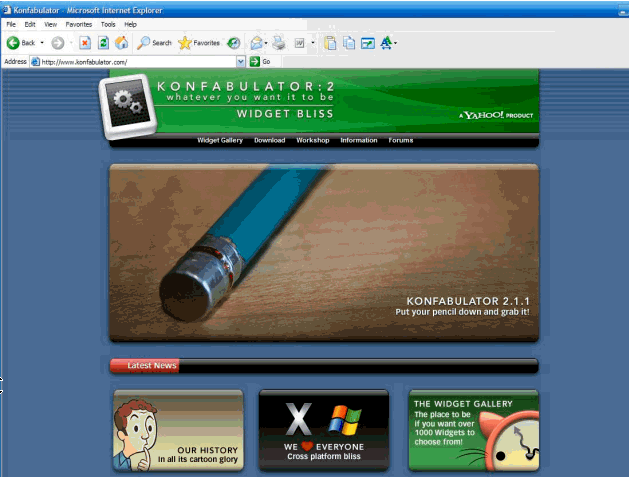
To download this program click on the download link at
the top of the main web site.
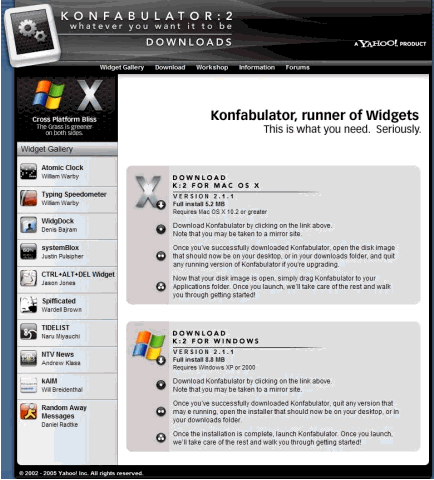
Click on the "Full Install 8.8 MB". The File download
window will appear. Click on "Save"
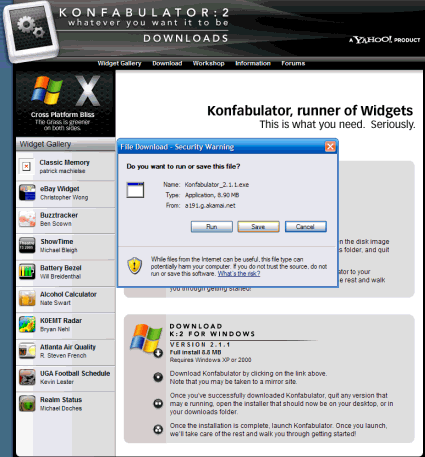
A window asking where you want to save it will then
come up choose a common location like My Documents and click
"Save".

A window asking you to Run or Don’t Run will then
appear, select "Run"
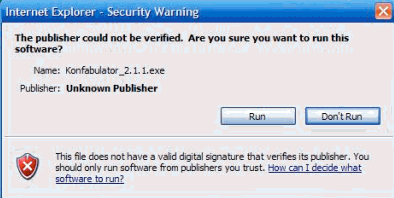
When the install window appears select "Next".
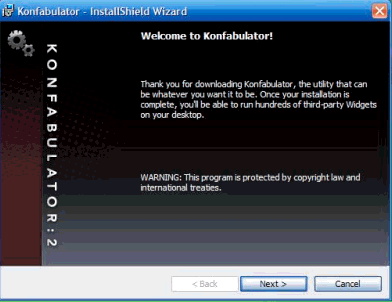
Select I Agree and hit "Next".
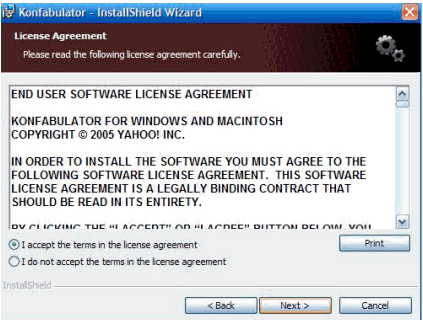
More prompts will come up. Select "Next" on them
until you come to the finish screen.
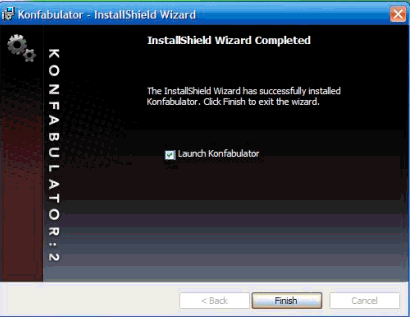
Click on "Finish" to launch the program. An Icon will
appear in the system tray that you can click on to access more
widgets or adjust the ones you have open
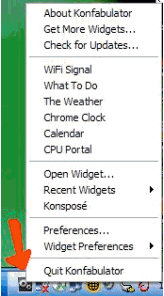
Yahoo is acquiring Konfabulator this year which will
make the widgets available to many more people. http://www.macworld.com/news/2005/07/24/konfabulator/index.php
Once the basic software is installed you can pick and choose from a
myriad of widgets to install, including a wide variety of designer
clocks and timers, from a simple digital display to a simulated
chrome clock.

The widgets can be set to float on other programs,
hide behind them, or only be visible by hitting F8. Right click on a
Widget to access the properties to change these features
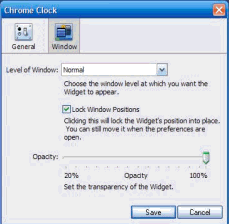
The screen called Konpose can instantly retrieve to
the screen all widgets by the push of a button [f8] for easy viewing
and customization.
 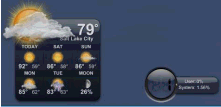
Widgets are treated like programs and so the more
widgets you have running the potential for processor speed problems
arise. Those with performance problems should limit the amount
of unnecessary programs running in the background. Some
widgets require constant internet connection to work and others are
stand alone. Download whatever widgets fit your computer
capabilities. All pictures and links are found on Yahoo.com.
Seminar Feedback:
'I attended the Ensign Training Seminar in Salt Lake City about 3
weeks ago . . . met Howard and his brother John . .
absolutely brilliant, professional people. The seminar covered
most aspects of Ensign, but rather quickly . . users
were encouraged to ask questions after the coverage of a specific
topic. Overall worked well.
On both days in the afternoon, an additional benefit was the
presentation by Larry Pesavento (about 2 hours each day). See
http://www.tradingtutor.com/index.html.
Larry has been in the trading business for close to a half century,
experienced every imaginable market event, traded stocks, bonds,
commodities all over the world. He is an entertaining,
engaging and very knowledgeable speaker and a very successful trader
(different league than those in this Group). I encourage
everyone to take the opportunity to listen to him at least
once. Larry has traded together with and enjoys close
relationships with Bryce Gilmour ( Gartley patterns) and Mark
Douglas ("The Disciplined Trader") among others.
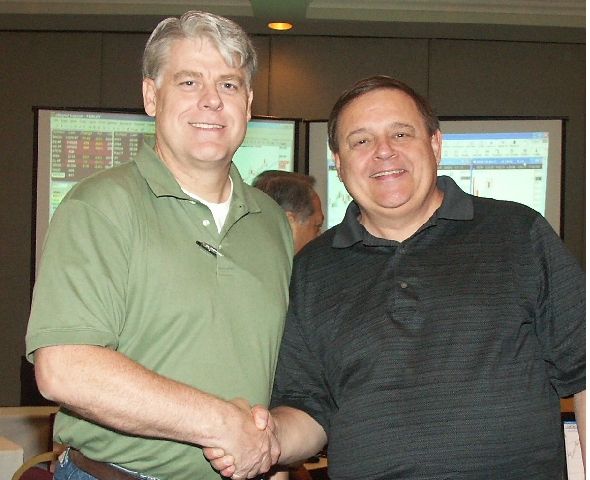
(Howard Arrington on the left and Larry
Pesavento on the right)
Contrary to my original assumptions, the Design Your Own™ (DYO)
is a very very powerful tool . . . I encourage every Ensign user to
investigate the power behind DYO . . . not merely as an indicator
but as a programming tool. You will be amazed. The
professionals know how to take advantage of powerful tools.
As an example of the power of DYO, Howard took us through
programming Larry's
Opening Price Principle. See the book Opening Price Principle for details. A DYO
is a very powerful tool, not merely a new indicator/study. The
DYO is a different kind of programming tool, different than the
Ensign Software Programming Language called ESPL. ESPL, based
on and written in Pascal, is a programming language for Ensign
Windows. Those comfortable with computer programming and like to
write efficient code could use ESPL.
DYO is a higher level tool that does what ESPL does (mostly). One
does NOT have to be a "computer programmer" to build programs with
DYO . . just a meticulous logical thinker !!!
Don Hall, the author of Pyrapoint, was an attendee. Howard
covered the details of how exactly Pyrapoint works . . .
fascinating revelations. I, however, do not use Pyrapoint.
Since Ensign/eSignal is my primary charting/programming tool of
the markets, I decided to attend the Ensign seminar.
Meeting all the people behind the scenes was invaluable. Overall,
the 2 days and $300 I invested in the seminar was the best decision
I made in a long time !!!
There are many many ways to make money/living in the
markets. Eventually you must develop your own methods
and adapt these as the markets/technology change.
Exploring the power of your tools is an investment and an absolute
requirement. As another great trader, Tim Morge, says "Master
Yourself, master your tools".
If Howard runs another seminar, I encourage every Ensign Window
user to attend.' -M. Appapillai
08-08-2005
'My age (77) dictates that I have likely attended more seminars
of this type than most. I can sincerely say that this rates as
the best in my experience. It was well organized, had
excellent script back-up, and was quite professional in all
respects. My sincerest congratulations for a job well
done!' -Don Hall 07-23-2005
'I just wanted to let you know how much I enjoyed the Salt Lake
Seminar. The quality of the seminar reflected the
preparation and thoroughness of you and your staff. Although
most of the attendees were seasoned traders, even a relative
newcomer such as myself was able to benefit greatly from the
information presented.' -A. Rosenberg
08-01-2005 |